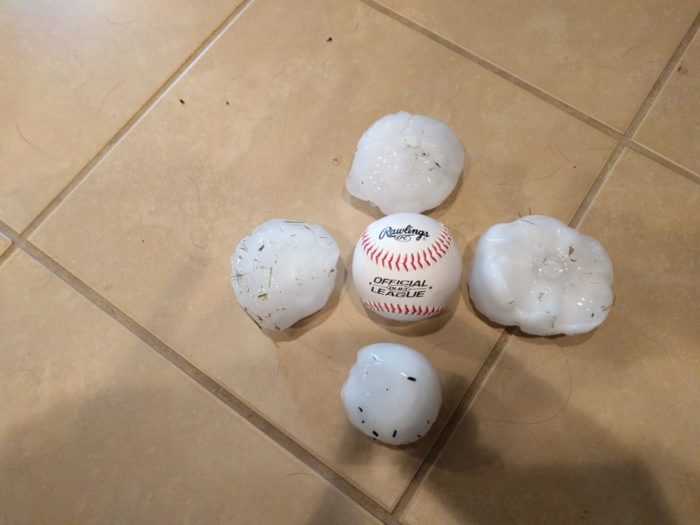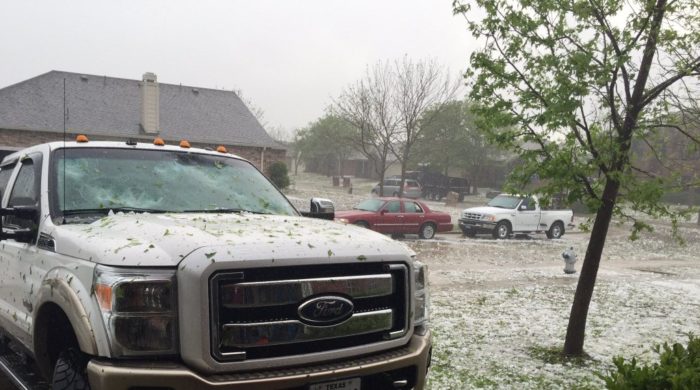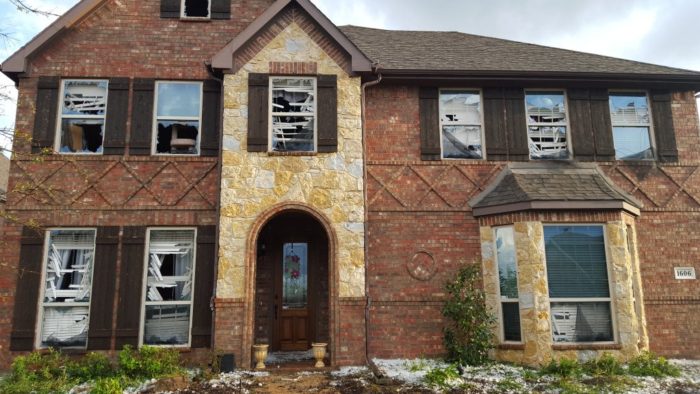Hagelstenen ter grootte van een softbal richten schade aan in Texas
Hail in Wylie – David Mulford

http://www.severestudios.com/2016/04/11/hail-wylie-texas-david-mulford/
Hail Damage in Wylie, Texas Today

Look at the windshield! RT @imaknight
Damage in Wylie, TX at my sister’s house. Baseball sized hail took out windows!
http://www.severestudios.com/2016/04/11/hail-damage-wylie-texas-today/
Severe thunderstorms hit parts of the Dallas-Fort Worth area of Texas on Monday, April 11, bringing softball-sized hail to Wylie. Wind gusts of up to 70 mph were reported throughout the region, while Oncor Electric Delivery said more than 10,000 people had no power, reported The Dallas Morning News. This drone footage shows a shelf cloud in Wylie. The green color is due to the refraction process through the hail, according to a meteorologist.
Insane Hail Destroys Neighborhoods Near Dallas, TX

Damage reports still coming in from Wilie, Texas from yesterday when baseball hail destroyed homes, cars and other property north east of Dallas, Texas. April 11, 2016. (Image via @wyliebear1 via Twitter)
Source: Washington Post
Bron:http://www.severestudios.com/2016/04/12/insane-hail-destroys-neighborhoods-north-east-dallas/
Overstromingen Houston Texas
Het blijft in Texas maar doorgaan. Van enorme hagelstenen naar overstromingen.NASA's GPM Looks at Texas Heavy Rainfall
A slow-moving frontal system associated with a stagnant upper-air pattern set the stage for heavy rains and flooding early this week from East Texas all the way up through the Central and Northern Plains. NASA estimated the heavy rainfall using satellite data that showed the hardest hit region was in and around the Houston area.
NASA's IMERG showed heavy rainfall from April 15 to 19 for eastern Texas and the surrounding region,. At least 6 to 12 inches (shown in dark red, purple and pink) covering most of East Texas, eastern Oklahoma and the far western portions of Arkansas and Louisiana. North and west of Houston almost 15 inches of rain fell (coral).
Credits: NASA/JAXA/SSAI, Hal Pierce
The Global Precipitation Measurement or GPM mission core satellite provides next-generation observations of rain and snow worldwide every three hours. NASA and the Japanese Aerospace Exploration Agency (JAXA) co-manage the satellite. The data provided is used to unify precipitation measurements made by an international network of partner satellites to quantify when, where, and how much it rains or snows around the world.
On Monday, April 18 the National Weather Service reported that Houston International Airport broke its all-time daily rainfall record with 9.92 inches of rain. Elsewhere in Harris County, over 17 inches of rain was recorded as of Monday evening. The main culprit was a stationary upper-level low pressure center spinning over the Central Rockies that had become detached from the main jet stream, causing it to remain in place.
At the surface, the corresponding north-south oriented frontal system, which extended from the Southern into the Northern Plains, pulled up stationary across Central Texas. The result was a steady flow of warm, moist unstable air being drawn up from the Gulf of Mexico northward across East Texas, which set the stage for and fueled numerous showers and thunderstorms across the region, including a massive thunderstorm complex that slowing moved across East Texas.
The Integrated Multi-satellitE Retrievals for GPM or IMERG is used to make estimates of precipitation from a combination of passive microwave sensors, including the GMI microwave sensor onboard the GPM satellite, and geostationary IR (infrared) data.
The data was created into an image at NASA's Goddard Space Flight Center in Greenbelt, Maryland and included IMERG rainfall estimates for the period from April 15 at 00:00 UTC (April 14 at 8 p.m. EDT) to April 19 at 08:30 UTC (4:30 a.m. EDT) for eastern Texas and the surrounding region.
IMERG showed rainfall amounts of at least 6 to 12 inches covering most of East Texas, eastern Oklahoma and the far western portions of Arkansas and Louisiana. The highest totals are located north and west of Houston and are near 15 inches. So far 5 persons are reported to have died in the area as a result of the some of the worst flooding there since Tropical Storm Allison in 2001. For updated forecasts, visit:www.weather.gov.
On Wednesday, April 20, 2016, the National Weather Service Weather Prediction Center in College Park, Maryland said "Showers and thunderstorms will continue over already soaked portions of the Texas Gulf Coast and portions of the southern Plains. The system that brought widespread heavy precipitation flooding to portions of the southern and central plains will slowly track to the east through the end of the week. "
Bron: http://www.nasa.gov/feature/goddard/2016/nasas-gpm-looks-at-texas-heavy-rainfall

 Enorme schade door hagelstorm Texas
Enorme schade door hagelstorm Texas




